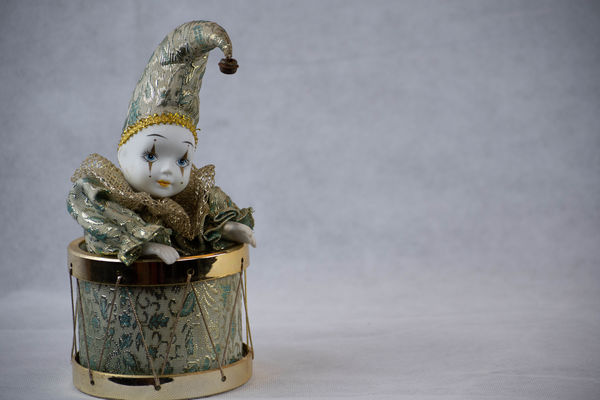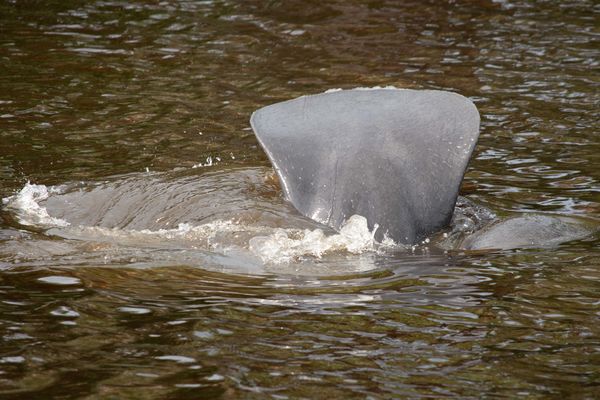Posts for: stanperry
Oct 6, 2018 13:06:06 #
Mary in SC wrote:
I just bought a Nikon D 500. When I hit the photo... (show quote)
I didn’t see where you say that the photos are perfect/missing/messed up on your laptop.
Sep 25, 2018 14:01:38 #
Well, now you have it all. From leave it alone to blow it with canned air that will void your warranty. The complete uhh opinion poll.
You paid a couple of grand for that camera. Why would you ever consider doing ANYTHING that you won’t do without asking how to do it or if you should do it???
You paid a couple of grand for that camera. Why would you ever consider doing ANYTHING that you won’t do without asking how to do it or if you should do it???
Sep 24, 2018 09:32:52 #
brianmen wrote:
I have learnt a new (for me) method the Street thi... (show quote)
Barcelona is unique. Pick pocketing there is a family business for eons, the skills taught by fathers to sons, and proficiency is admired. Everywhere is suspect and you can be targeted walking, riding buses or trains, etc. they know about every device sold that supposedly prevents pickpockets from success, and they can overcome those devices quite readily. Be careful everywhere in Barcelona, but really careful on Las Ramblas.
Sep 23, 2018 21:37:43 #
I have to agree that it's overlooked. I love the effect, but it IS an effect. It becomes like an abstract painting, where you know that the pic looks like nothing real, and showcases ones proficiency with photoshop. That is not what photo contests should be about.
Sep 22, 2018 16:09:48 #
amfoto1 wrote:
Hi Daniel, br br In addition to online resources ... (show quote)
Also be aware that many of the sites, such as Getty, will have the exclusive right to sell your work. That means you can ONLY publish that photo on their site. Most of the other sites aren't exclusive so you can publish to shutterstock, adobe, and as many others as you like. And the comments above are incorrect in that. You can publish the exact same image over and over to the sites. You don't have to have multiple views or change them in any way. So then you are faced with a choice......publish your photo on Getty (exclusive rights sites), which pay much better per image sold (the key word is "sold") or take a smaller pay check from other sites, with the additional opportunity to sell across multiple platforms. Keep I'm mind that Getty also charges significantly more for images to their buyers, and buyers are also shoppers. An image on Getty may cost $100. A similar image on shutterstock will cost $10. Personally, I won't publish to an exclusive rights type clearing house. I prefer to spread my opportunities to sell something across a larger audience.
Sep 21, 2018 11:57:44 #
I do stock photography, in addition to my other camera work. I thought it might be helpful to give you my perspective. At the moment, I have more than 500 pics uploaded to 5 sites. My average monthly income buys me dinner, once (only mine. Not my wife's). Before you decide to get started, you really need to understand that there is no money in it. None.
Your uploads will be reviewed by other contributors. You should expect a 30-40% rejection rate at first. Rejections for focus, noise, etc, will be a startling revelation. Each of your submissions must be technically perfect. Other submissions will be rejected for a plethora of CYA rules, such as model releases, artwork releases, visible logos/trademarks, etc. Reviews are consistently inconsistent both inter- and intra- agency submissions. Monday a picture of a vase and flowers will be rejected for lack of an "artwork" release (they cannot define artwork. I seriously have had pics of common, everyday items rejected for this reason). If you had waited until Tuesday, however, it would have been accepted without hesitation. I often wonder if the reviewers bias their rejections in favor of their personal areas of interest. By the way, don't bother using the contact us button for a reason. The little guy who answers these lives in the Philippines and doesn't own a camera. And the company doesn't care. They have thousands of daily contributors, and millions upon millions of photos. Btw, the Phillipino dude, or Taiwanese or Pakistani either don't habla Ingles, or barely do. No 50 cent words in your emails, please.
10's of thousands of photographers are competing for the 25 cent royalties paid for a download. Submitters are from every walk of life. Housewives, students, pro's, and now, apparently, you. You must understand the enormity of your task. You hope/think that your images will be selected by Coca Cola for an upcoming ad campaign. Coca Cola sets their ad team to work finding just the right image. They then review 120,000 images. And they pick yours. Really??? But, they did. They then pay $1.25 to shutterstock for the unlimited use of your photo. Shutterstock the sends you .17, if you're a newbie. If you've uploaded 1000 images and sold some ambiguous number of them, your rate may be higher, and your direct deposit will be $.25. If you have questions about that, go to a stock website and do a search for any subject no matter how obscure (I.e., lady bugs in April in the Catskills, etc). Then review the 500 pages of images. Get it? Take the dollars that you need/want to make and divide that by 25 cents. To get $300 you have to sell ??.?? images per month. The only upside to that is that after you have uploaded enough images to actually make money, that income will continue in perpetuity. The royalties are paid forever.
Your photoshop skills need to be good. Your images need to be perfect (I spent a few weeks trying to resolve a noise issue that really wasn't an issue EXCEPT at this level of review. ANY noise will get you a rejection notice. Wedding photos for printing are less picky). Your subject matter must be relevant and sought after (relevancy changes daily). You will spend a lot of time and effort to make a quarter. The people who make a living at it must be submitting 100 images/week, and have, for years. YOU on the other hand, haven't and won't. I submit images when the Real Estate, Advertising and crime scene business is slow. I expect to surpass 1000 uploads by the end of October. I'm also semi retired, so I don't need the money. Thank God.
So.......if you want to do it just to say you did, go ahead. If there's any other reason, just don't. You will spend more time keeping up with which images were uploaded to which sites,,which sites rejected which image and why, than its worth. You'd be better served to print and frame your best work and shop them to professional galleries. The stock photo rejection rate alone will depress you.
On the upside, you will get professional level reviews of your images. Pay attention, and the quality of your photos will be greatly improved. You can make money, if you blast images to multiple sites consistently over a long period of time. Also, the Royalties paid forever is attractive, if you jump in with both feet and upload tons of pics. Getting those quarters when you're retired would be nice.
Your uploads will be reviewed by other contributors. You should expect a 30-40% rejection rate at first. Rejections for focus, noise, etc, will be a startling revelation. Each of your submissions must be technically perfect. Other submissions will be rejected for a plethora of CYA rules, such as model releases, artwork releases, visible logos/trademarks, etc. Reviews are consistently inconsistent both inter- and intra- agency submissions. Monday a picture of a vase and flowers will be rejected for lack of an "artwork" release (they cannot define artwork. I seriously have had pics of common, everyday items rejected for this reason). If you had waited until Tuesday, however, it would have been accepted without hesitation. I often wonder if the reviewers bias their rejections in favor of their personal areas of interest. By the way, don't bother using the contact us button for a reason. The little guy who answers these lives in the Philippines and doesn't own a camera. And the company doesn't care. They have thousands of daily contributors, and millions upon millions of photos. Btw, the Phillipino dude, or Taiwanese or Pakistani either don't habla Ingles, or barely do. No 50 cent words in your emails, please.
10's of thousands of photographers are competing for the 25 cent royalties paid for a download. Submitters are from every walk of life. Housewives, students, pro's, and now, apparently, you. You must understand the enormity of your task. You hope/think that your images will be selected by Coca Cola for an upcoming ad campaign. Coca Cola sets their ad team to work finding just the right image. They then review 120,000 images. And they pick yours. Really??? But, they did. They then pay $1.25 to shutterstock for the unlimited use of your photo. Shutterstock the sends you .17, if you're a newbie. If you've uploaded 1000 images and sold some ambiguous number of them, your rate may be higher, and your direct deposit will be $.25. If you have questions about that, go to a stock website and do a search for any subject no matter how obscure (I.e., lady bugs in April in the Catskills, etc). Then review the 500 pages of images. Get it? Take the dollars that you need/want to make and divide that by 25 cents. To get $300 you have to sell ??.?? images per month. The only upside to that is that after you have uploaded enough images to actually make money, that income will continue in perpetuity. The royalties are paid forever.
Your photoshop skills need to be good. Your images need to be perfect (I spent a few weeks trying to resolve a noise issue that really wasn't an issue EXCEPT at this level of review. ANY noise will get you a rejection notice. Wedding photos for printing are less picky). Your subject matter must be relevant and sought after (relevancy changes daily). You will spend a lot of time and effort to make a quarter. The people who make a living at it must be submitting 100 images/week, and have, for years. YOU on the other hand, haven't and won't. I submit images when the Real Estate, Advertising and crime scene business is slow. I expect to surpass 1000 uploads by the end of October. I'm also semi retired, so I don't need the money. Thank God.
So.......if you want to do it just to say you did, go ahead. If there's any other reason, just don't. You will spend more time keeping up with which images were uploaded to which sites,,which sites rejected which image and why, than its worth. You'd be better served to print and frame your best work and shop them to professional galleries. The stock photo rejection rate alone will depress you.
On the upside, you will get professional level reviews of your images. Pay attention, and the quality of your photos will be greatly improved. You can make money, if you blast images to multiple sites consistently over a long period of time. Also, the Royalties paid forever is attractive, if you jump in with both feet and upload tons of pics. Getting those quarters when you're retired would be nice.
Sep 9, 2018 10:26:36 #
I use a laptop. I connect it to my 4K television via Bluetooth. It’s awesome.
Sep 9, 2018 10:18:48 #
aly1235 wrote:
One of my family members asked me to shoot their w... (show quote)
Your friends will get what they pay for. The pros have a lot invested in their business and equipment, and bring experience and know how to the table. Weddings are particularly challenging, and if it’s not done right, the event is forever lost and the only thing they will remember is who messed up the photos.
Having said that, do your best to PLAN. Work with them long before the wedding to ensure you know exactly where everything takes place, where people will stand, etc, and plan your shoot. You probably don’t want to disrupt things by walking around taking pics while the vows are said. Be somewhere with a great vantage point. Look at weddings done by pros, and stage some pics. Have every guest with a camera send you copies to fold into the portfolio. Just do your best, cross your fingers and shoot away. A wide angle lens inside, a zoom lens for close ups and portrait work. Get your manual skills up to par and use some skill capturing images in low light, and shoot as much as you can outdoors. The bride/groom walking into the church singly and out of it as a couple, etc. like I said....PLAN. Good luck.
Sep 5, 2018 20:03:39 #
I want bright yellow. It would be easier to identify if someone took an unnatural liking to it.
Sep 5, 2018 19:59:41 #
jimkh wrote:
Thanks so much to all. I've found the best tip is th 1/60 second shutter which seems to eliminate all those irritsting lines. You can't stop action too well but you can't win them all.
Again thsanks to the Hedgehogs for all the good tips which I will try and use.
Jim
Again thsanks to the Hedgehogs for all the good tips which I will try and use.
Jim
Can’t you just use video to record, and extract the stills you want in post?
Sep 4, 2018 00:01:55 #
SteveR wrote:
My eyes must be missing something. What noise are you talking about?
The noise in the first two. ISO 400. Take it up to 1:1
Sep 3, 2018 19:51:56 #
stanperry wrote:
I'm using the factory preset spot metering
I misstated.,,it’s matrix metering....the factory default.
Sep 3, 2018 16:44:54 #
Gene51 wrote:
So you had an A-HAH! Moment. Good for you. There is something to the new crop of cameras coming out from Nikon, Sony and others. They've figured out how to avoid having the cameras contribute any noise of their own.
I’m not sure what Cam b meant
Sep 3, 2018 15:02:30 #
R.G. wrote:
Even the outside shots seem a bit on the dark side. What metering are you using? I believe that the D500 has metering for highlights as an option. If the highlights are extreme or pronounced it might cause the exposure to be lower than what matrix metering or some such would give.
I'm using the factory preset spot metering
Sep 3, 2018 12:34:45 #
These were taken about a month earlier, same camera, 35mm lens.


